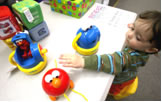Frequently Asked Questions About Lead Poisoning




- Who's most at risk for lead poisoning?
- Why is lead a health problem?
- Can adults get lead poisoning?
- I'm pregnant. What's my risk? (PDF - 411kB)
- Do people with lead poisoning have symptoms?
- Should I have my child tested?
- How can I find a low-cost health care provider?
- What are possible sources of lead in my home and how could they affect my children?
- What about leaded toys?
- How can I find and reduce lead hazards?
- How to hire and work with contractors.
- What laws protect children from lead?
- Who is the Alameda County Lead Poisoning Prevention Program?
Who's most at risk for lead poisoning?
Children under six years of age are the most at risk. They often play close to the floor and put things in their mouths. These natural behaviors make them more likely to be exposed if there are lead hazards around them. If lead is swallowed, a young child's body tends to absorb lead into the blood more readily than an adult's body. Children who have diets that are low in iron and calcium tend to absorb more lead, so good nutrition is one important factor to prevent lead poisoning. Older homes, built before 1978, with peeling paint, pose the most risk for young children.
Lead poisoning can interfere with critical stages in a young child's development. It can affect the development of a child's brain, bones, and internal organs. Children with lead poisoning can have learning disabilities, growth delays, behavior problems, and other developmental delays.
Pregnant women exposed to lead should ask their doctor about a blood test. Lead crosses the placenta and has harmful effects on the fetus. An infant born to a mother with an elevated level of lead in her blood would be at risk for lead poisoning.
Why is lead a health problem?
Lead is a heavy metal that is a neurotoxin, which means that it can harm the brain. It also harms bones and internal organs. Children with lead poisoning can experience delayed development and behavioral problems. Lead poisoning usually occurs through ingestion, which means that the lead is unintentionally swallowed.
Can adults get lead poisoning?
Most adults are not at risk, unless they work with lead in some capacity. Adults with lead poisoning can suffer from damage to the nervous system, reproductive system, digestive system, and kidneys.
If you have questions about occupational lead exposure, make sure to call the California Occupational Lead Poisoning Prevention Program at (510) 620-5757 or (866) 627-1587 for more information.
Some of the types of work that might expose an adult to lead would include working in the construction industry, doing painting and carpentry on older homes, working on automobiles (especially in radiator shops), working in a foundry or in metal casting, or working in plating operations. These are just a few examples of occupations which might expose workers to lead.
Adults who work with or around lead can unknowingly bring lead dust home on their work clothes and shoes. This can cause their children to be exposed to lead.
Doing renovations in homes built before 1978 can also produce lead dust hazards, if the work isn't done in a lead-safe manner. These hazards can affect the adults doing the renovations, pregnant women and young children who live in or visit a home where renovations are or have taken place.
Pregnant women exposed to lead could have lead in their body, and their baby could be born too early or too small, have health problems, and have problems learning. The only way to know if you have lead in your body is to have a blood test for lead.
Do people with lead poisoning have symptoms?
Children with lead poisoning often have no symptoms. The only way to tell is to have your child tested. A child can be poisoned and show no outward signs. When there are symptoms, they can include diarrhea, stomach cramps, lethargy, vomiting, or seizures in some severe cases.
Should I have my child tested?
Children under six years old should be tested. Children ages one to three are at the greatest risk. Very young children spend the most time on the floor and are the most likely to put objects or their hands into their mouths. Young children who live in older homes are at a higher risk, because there's a greater likelihood there will be lead-based paint hazards in or around their home. Any child who may have been exposed to lead should be tested.
Ask your doctor or health care provider to test your child. Lead is absorbed by the body primarily in blood. To know if your child has an elevated blood lead level you can request that your child get a simple blood test. Your physician can order this test. Call our information line if you would like to discuss what the blood lead level results mean or need help getting your child tested.
How can I find a low-cost health care provider?
If you don't have health insurance or a health care provider there are resources available to help you find a medical home for you and your child. The Alameda County Access to Health Care Collaborative is an information resource for uninsured Alameda County residents seeking free or low-cost health care. http://ACHealthCare.org provides information on qualifying for health insurance, a place to search for a doctor or clinic, and information about other social services. It is important that your child get regular well baby exams and health care as well as blood lead testing. To find a free or low-cost doctor or clinic go to http://achealthcare.org/
What are possible sources of lead in my home and how could they affect my children?
Your home could have a number of potential sources of lead, but you may not be aware of some of them. The most common sources of lead in the home are PAINT, DUST and SOIL. Learn more...
How can my child be exposed to lead from toys?
Children may be exposed to lead from toys that have been made in other countries and then imported into the country. The U.S. Consumer Product Safety Commission (CPSC) issues recalls of toys that could potentially expose children to lead. Children may be exposed to lead from consumer products through normal hand-to-mouth activity.
The only accurate way to test a toy for lead is by a certified laboratory. Do-it-yourself kits are available at your local hardware store. However, these kits do not indicate whether the toys are safe. If you have any reason to suspect that your child has been exposed to lead, remove the toy from your child. Your child's health care provider can help you decide whether to perform a blood test to see if your child has an elevated blood lead level. Learn more...
How can I find and reduce lead hazards at my property?
If you own a residential property built before 1978 in Alameda, Berkeley, Emeryville or Oakland, you are eligible for a free phone consultation to help you identify and reduce lead hazards in your home. If you are a tenant, let your landlord know that this service is available to them at no cost to them.
Most homes built before 1978 have lead-based paint under the surface layer. You can save the cost of hiring a lead-certified inspector/risk assessor by presuming there is lead-based paint, since it is so common in older homes. If you do decide to hire an inspector or to send samples to a laboratory for analysis, see our page on How To Test For Lead.
Painting and renovation projects can create hazardous levels of lead dust. If you plan to conduct work on your property yourself, read about reducing lead hazards and find out about where to get lead safety training.
If you plan to hire a contractor to paint or renovate your home, see our guidance on How to Hire a Lead-Safe Contractor which includes a list of local lead-safe certified contractors.
Call the Lead Poisoning Prevention Program's Lead Safety Information Line at 510-567-8280 for more information.
How can I make sure a contractor is doing lead-safe work?
Lead-safe work practices are now required by State and Federal law. First, ask to see their EPA Lead Renovation, Repair and Painting (RRP) Certificate. Unfortunately not all contractors are in compliance. But there are several steps you can take to improve the chances of hiring someone who has the knowledge and experience to handle your job.
All building contractors who work on your property are required to be licensed by the Contractors State License Board. Ask to see their pocket license and another form of identification. Ask the contractor if the company is insured against claims covering workers' compensation, property damage, personal liability and lead liability in case of accidents or lead exposures. Ask about experience relevant to the work you need done.
Meet with the contractor when s/he comes to look at the job. The way a person examines the site can give you clues as to how they will perform on the job. It may be an indication that they will plan well and pay attention to the details when they are doing the project. Ask the contractor how they will do the work and what his/her plans are for containment, clean-up, worker protection and disposal.
Dust from uncontained sanding, scraping, water blasting or flame torching of lead-based paint can be very hazardous to residents and workers, and can contaminate your property. Regardless of whether or not they are lead certified, ask the contractor how they will minimize and contain the paint chips and dust. Will they put heavy plastic sheeting down? What kinds of tools will they use? Will they use a HEPA vacuum to clean up when they are done?
Insist on a written contract that spells out in detail what will be done, the work schedule, the price and the terms of payment. Make sure that everything you want done is included and that both parties understand and agree on the scope of work.
Pay attention to what is going on while the work is in progress. If you see things that look wrong, talk to the contractor about it right away. Keep the lines of communication open so little problems don't become big ones.
For more information, see How to Hire a Lead-Safe Contractor.
What laws protect children from lead?
Over the last decade a number of federal and state laws and regulations have been enacted. If you are a property owner, contractor, painter or maintenance worker, there are some particular regulations, described below, that are important to become familiar with in order to avoid fines and penalties. Learn more...
Who is the Alameda County Lead Poisoning Prevention Program?
Established in 1991, the Alameda County Lead Poisoning Prevention Program has become a national leader in childhood lead poisoning programs, combining health, environmental and residential hazard reduction services under one umbrella.
Thanks for getting informed!!
Please call our Information Line at
1-800-B-Lead-Safe or 510-567-8280
for more information on
any of these topics.
2000 Embarcadero, Suite 300, Oakland CA 94606
Phone: (510) 567-8280 Fax: (510)
567-8272
* Portable Document Format (PDF) file requires the free Adobe Reader.
 Community Development Agency
Community Development Agency ABOUT US
ABOUT US